Art World
Did Le Corbusier Fall in Love With Josephine Baker on a Cruise Ship? A New Film by Artists Gerard & Kelly Imagines Their Relationship
“Bright Hours” was filmed at the Cité Radiuese, Le Corbusier’s Modernist masterpiece in Marseille.
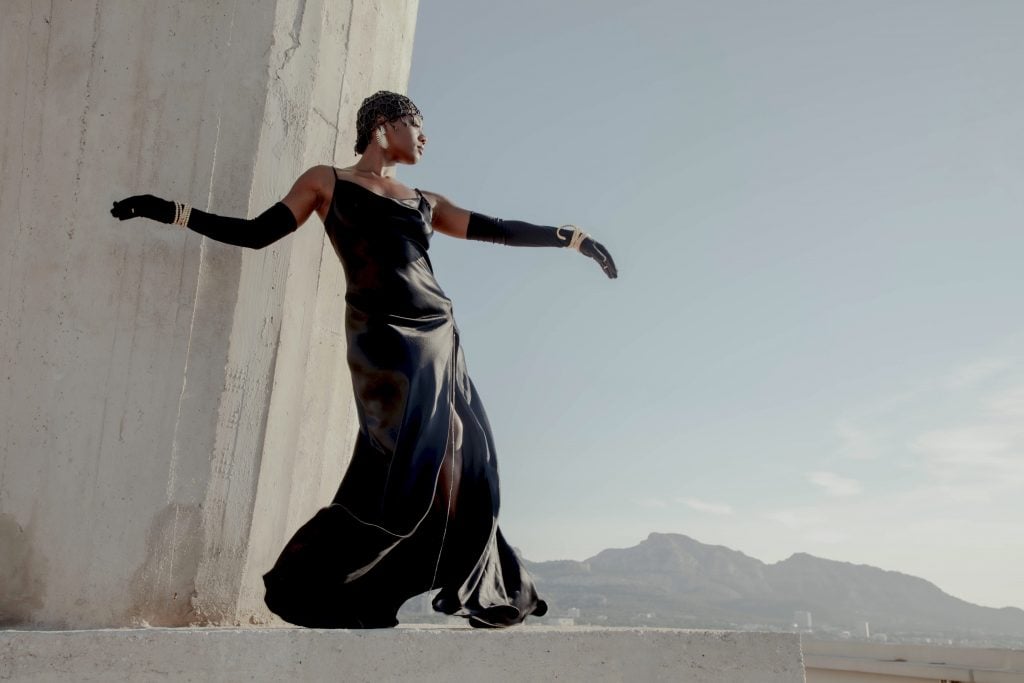
“Bright Hours” was filmed at the Cité Radiuese, Le Corbusier’s Modernist masterpiece in Marseille.

Christine Ajudua

Last Friday, at the Art-o-Rama festival in Marseilles, France, Brennan Gerard and Ryan Kelly—the American, Paris-based artists known as Gerard & Kelly—debuted the sixth chapter of their ongoing “Modern Living” series. The performance and video works explore bodies and architectures—as well as questions of gender, sexuality, colonialism, and race.
Since 2016, each chapter has been sited in a different Modernist building, from the Schindler House in Los Angeles to the Villa Savoye in Poissy, France. The latest iteration, Bright Hours, picks up where the last one left off, with Le Corbusier—or rather, with the architect after he met Josephine Baker.
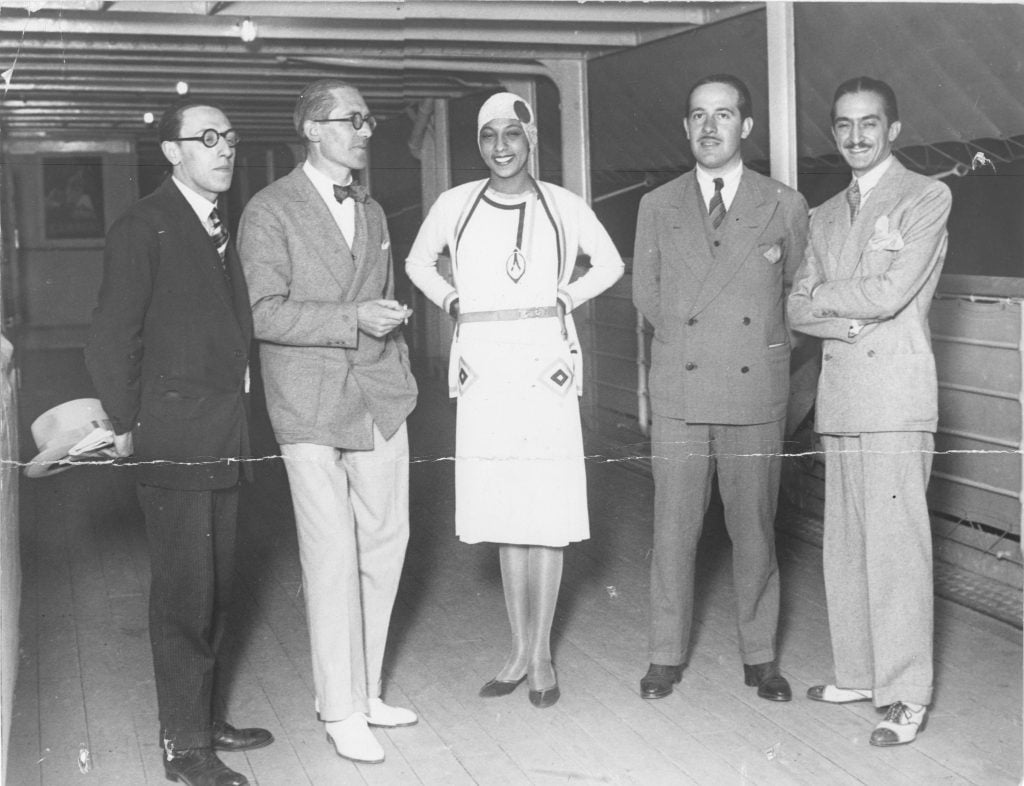
Le Corbusier and Josephine Baker (center) aboard the cruise ship Lutetia, 1929. Courtesy of Fondation Le Corbusier. ©FLC/ADAGP.
While in production for the Villa Savoye performance, the multidisciplinary artists—whose practice grapples with intimate relationships and their potential to spark social change—discovered that in 1929, the Swiss-French architect and the American star (and actress, and singer, and World War II spy) met in Brazil and together boarded a cruise ship back to France. During the journey, it is likely they had, in today’s parlance, a fling.
“This encounter—which, when mentioned at all, exists only as a footnote in each of their respective biographies—became the lens for us to see the whole of Le Corbusier’s architecture,” Gerard said.
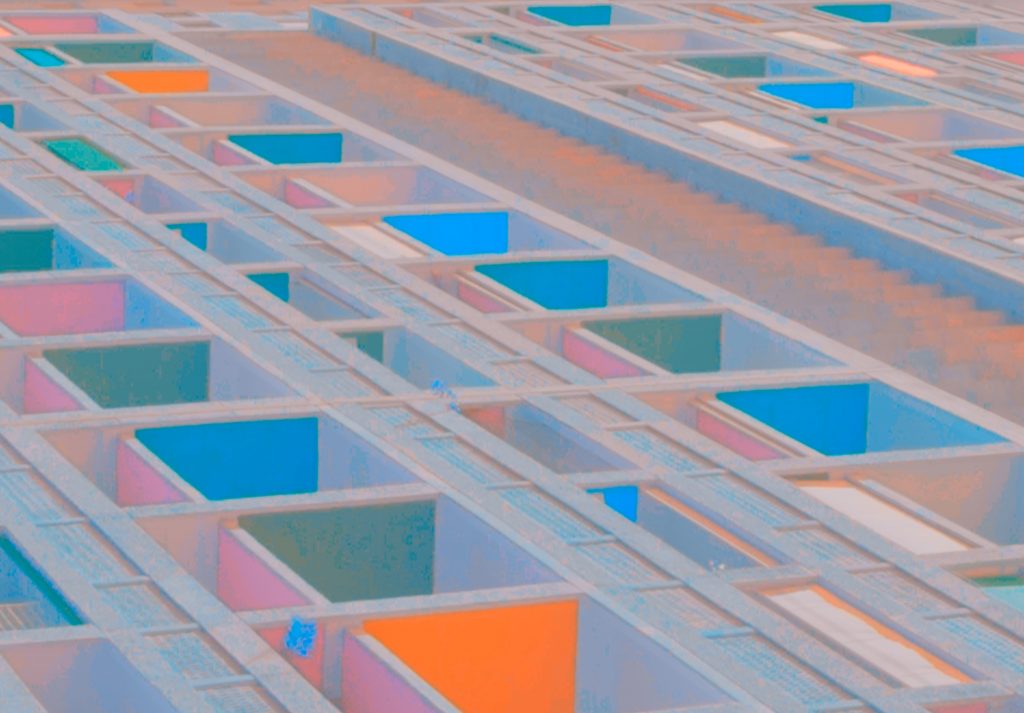
Gerard & Kelly, Bright Hours (2022). Courtesy of Gerard & Kelly and Marian Goodman Gallery.
Bright Hours was filmed at the Cité Radieuse (Radiant City), Le Corbusier’s postwar masterpiece, designed to house working-class and middle-class people in Marseille, with polychromatic surfaces that introduced color into his until-then largely whitewashed oeuvre. The piece reimagines the 70-year-old building, which has been named a UNESCO World Heritage site, as the transatlantic ship on which the architect fell for Baker.
With its soundtrack composed and performed by American musician Moses Sumney, based on the Baker songbook, the 25-minute film blurs the lines between fact and fiction. It also plays with gender roles, with the young, St. Louis-born dancer Emara Neymour-Jackson aptly playing Baker, while Le Corbusier is portrayed by the celebrated French actress Jeanne Balibar.
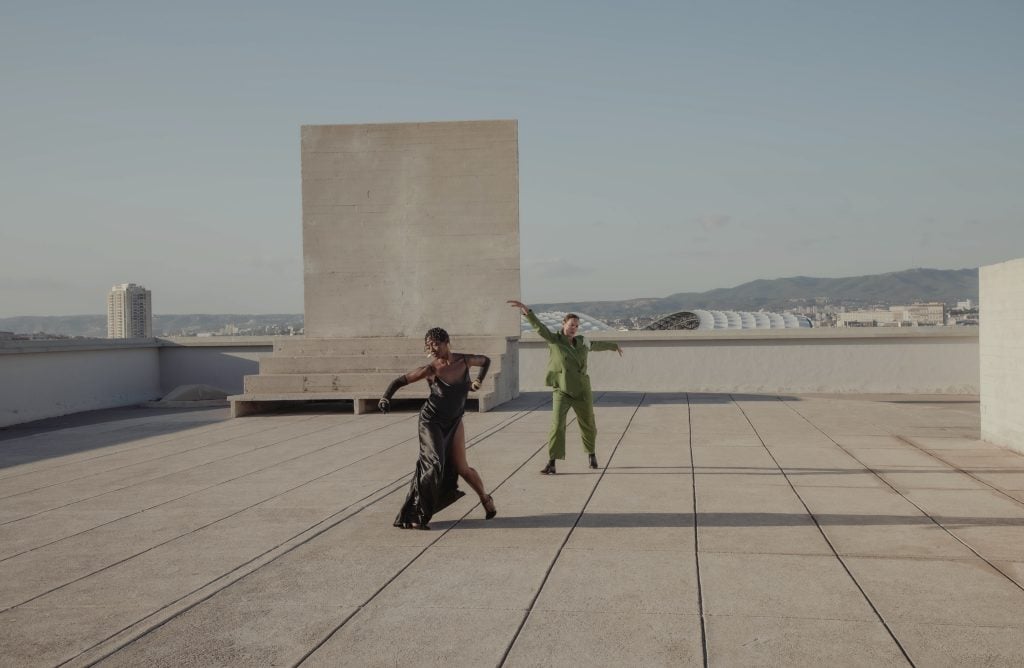
Emara Neymour-Jackson as Baker and Jeanne Balibar as Le Corbusier. Gerard & Kelly, Bright Hours (2022). Courtesy of Gerard & Kelly and Marian Goodman Gallery.
Bright Hours will be shown as part of Gerard & Kelly’s coming survey exhibition, “Ruines,” which is set to open this fall at the Carré d’Art in Nîmes, France (October 14, 2022—March 26, 2023). While in Marseille, the duo spoke with Artnet News about their contemporary approach to choreography, composition, and color (“We work with hybridity,” Kelly said); how they see Baker as a collage artist and Le Corbusier as a dancer; and why these two mythic figures of Modernism are both architects, in their minds.
How did you discover the story of Le Corbusier and Baker, and why did you want to retell it?
RK: We were in the archives of the Fondation Le Corbusier in Paris about three years ago, and came across a photograph of them together on a ship, taken at the captain’s dinner. Josephine had dressed up as Le Corbusier, and Corbusier as Josephine Baker. It was an image that piqued our interest.
BG: It became a way for us to see these kind of ruins of Modernism—Le Corbusier’s Cité Radieuse, as well as Josephine Baker’s performances—in ways that are more relevant for our current moment. Because I think that their intimacy is a very queer one.
RK: A 44-year-old, white European man and a 22-year-old Black American woman—um, that’s a complex relationship, even today [laughs].
Surely we speculate a bit on how much did or did not take place, but, you know, that fiction began with deep research—in the archives; reading critical analyses like Ann Cheng‘s Second Skin, a brilliant book on Baker and architecture; figuring out who was Le Corbusier, and who is Le Corbusier to us today.

A sketch of Le Corbusier and Josephine Baker in the architect’s notebooks from his voyage to South America, 1929. Courtesy of Fondation Le Corbusier. ©FLC/ADAGP.
So who was Le Corbusier, and who is he to you now? He’s a pretty controversial figure.
RK: I think Le Corbusier was a complicated figure of the 20th century, both visionary and blind in some ways. The part of him that believed in the potential of architecture to transform society is the part that is still valuable today, even more so. What we don’t want to lose as we take a critical look at the part of him that was so problematic, which was the ways that he couldn’t see—cultural difference, women, even America.
BG: He would write these elegies toward jazz or kind of luxuriate in his visit to the favelas in Brazil, but wouldn’t acknowledge those things as the sources of his creativity—very similar to the way Picasso dealt with non-Western cultures. It was a kind of appropriation without an understanding of context.
I think he had the same blinders on that a lot of people did, especially men—especially white men—in the early part of the 20th century. They could not see how their architecture, in order to be “new” or “modern” or “radical,” was already such a hybrid mix of so many different cultures.
But I think the larger thing is to say is that, that was Modernism—that was what was known as Modernism.
Le Corbusier is a myth. And I think that with this film, he becomes a human again.
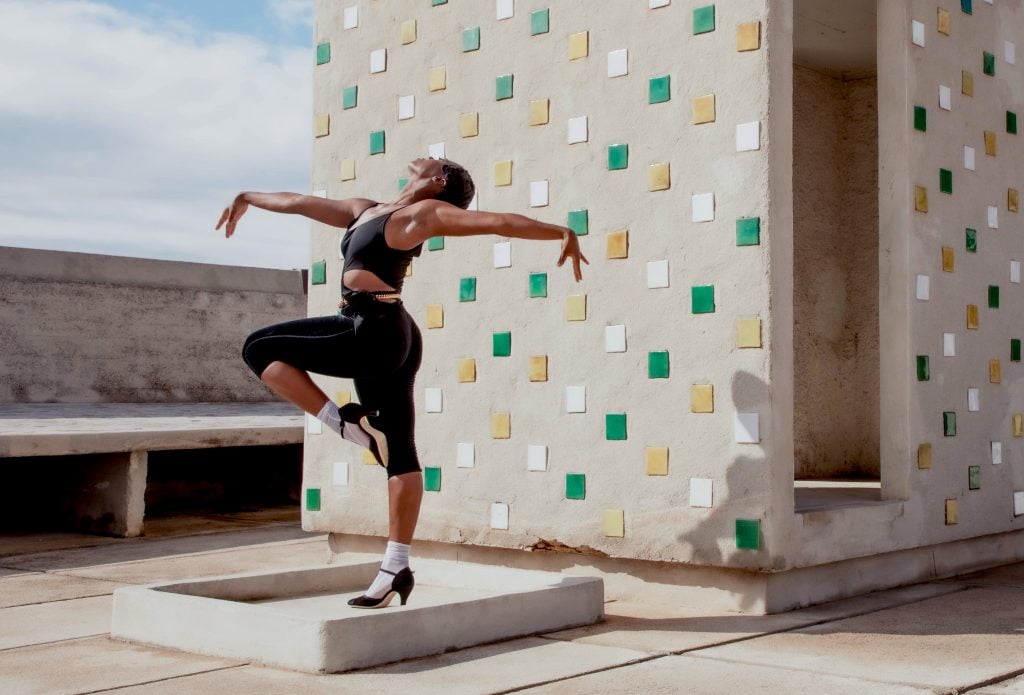
Neymour-Jackson as Baker in Gerard & Kelly’s Bright Hours (2022). Courtesy of Gerard & Kelly and Marian Goodman Gallery.
And what about Josephine Baker? Who was she, and who is she now?
RK: So in the film, when our Le Corbusier describes her as “just that beautiful goose from the village,” and “modest with a good heart”—that’s actually Le Corbusier’s writing in a letter to his mother about Josephine Baker.
We were interested in thinking of Baker as an agent of Modernism and not only its muse, which is pretty well founded in historical reading. She commissioned a Modern house from Adolf Loos that she then rejected and did not build. And she was looking for a Modern architect to build an orphanage for children from all over the world.
BG: We’re trying to suggest, what if Josephine Baker was, and is still, an architect of Modernism?
She’s this figure who kind of created our postmodern culture. Collage is the technique that you would associate with Picasso, but actually, what if we think of her as the original collage artist?
RK: In a way, as a collagist, she’s also a master of appropriation—even at the level of choreography. She would make these dances by mixing clichés and stereotypes of the white gaze with what she thought of as Afro-Caribbean dance, and her take on Martha Graham, thrown in with a little bit of, like, classical ballet—and this would all happen in about 10 seconds [laughs].
So she was playing with fire, and I like to imagine that she was well aware of it.
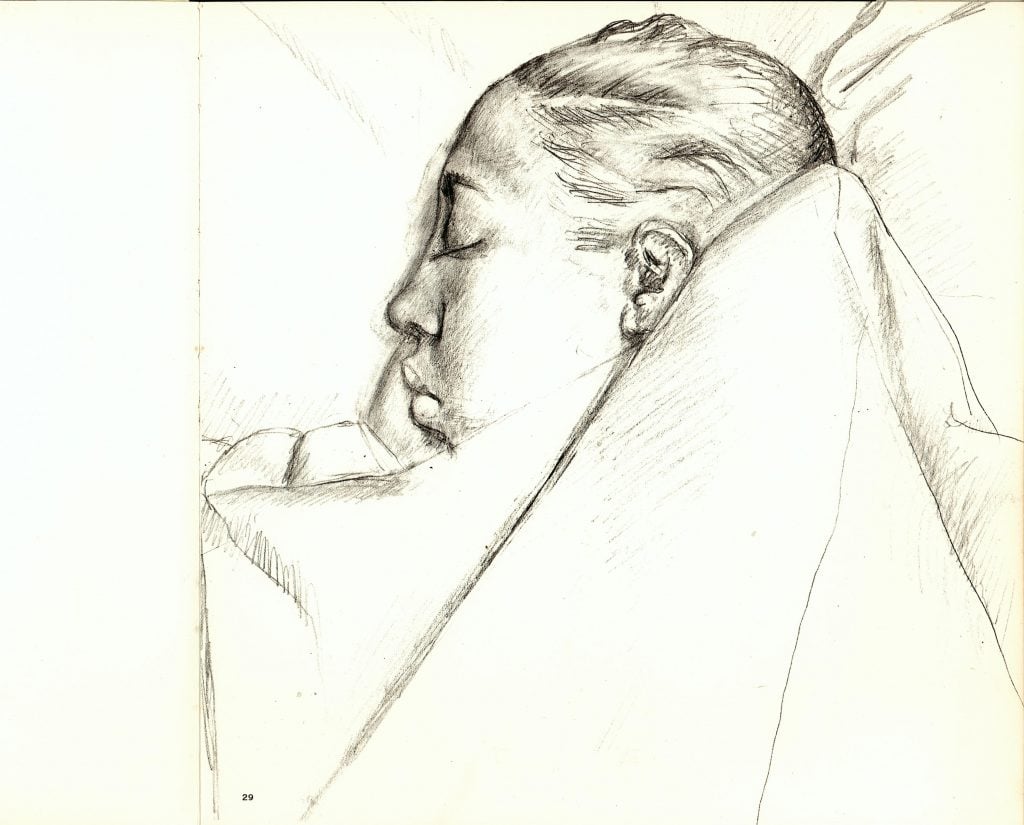
Le Corbusier’s drawing of Josephine Baker sleeping, 1929. (c) FLC/ADAGP.
Can you talk a bit more about Baker’s influence on Le Corbusier, and how much of that is fact versus fiction?
RK: That’s where we really speculate. I mean, we know that they had an affair. We know that they met in Rio de Janeiro. We know that they took the ship back together. In the archives, we found sketches Le Corbusier had made of Baker sleeping, and letters he had written to his mother from the ship describing the intensity of his encounter with her.
We know that he sent letters to Josephine 15 years later, telling her that he felt he had missed the chance with her—and then pivoting and asking her for money [laughs].
Where we took the poetic license was: What if this brief and intense encounter changed the way that Le Corbusier saw architecture, specifically by introducing color into his architecture? Which is true—he did introduce color over the following decades. And he stayed dedicated to this idea of color and to organic form, and the body being important.
We know that our most intimate encounters change the way we think and feel about everything, so it didn’t seem like such a big speculation to imagine that falling in love would change the way that he approached architecture, even decades later.
Le Corbusier had authoritarian views on whitewashing. Can you elaborate on his use of color—and on the role and meaning of color in Bright Hours?
BG: Le Corbusier was one of the few Modern architects to use color, especially in the post-war period and at the Cité Radieuse. Where did that come from? What does it mean?
We let color mean a lot of things in the film. When Josephine says, “This room is not white,” she means it quite literally, the Cité Radieuse is full of color. But she also means it culturally. This whole thing we call European modernism, well, it’s deeply indebted to the East, to the global south, to American and specifically African-American culture—to the spectrum of colors, of cultures.
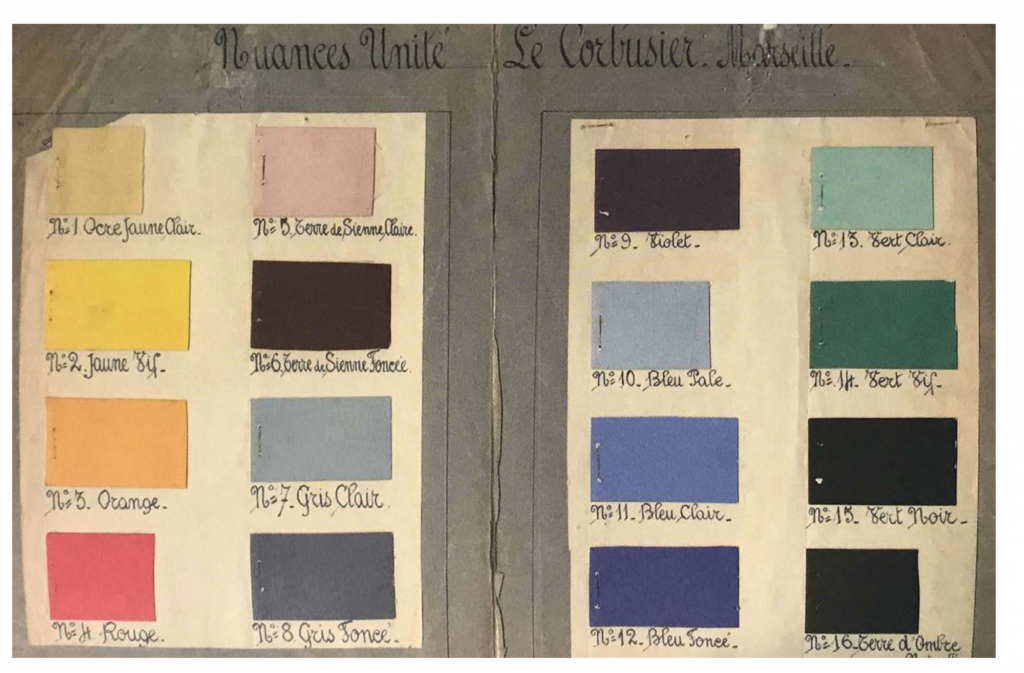
A color palette for Le Corbusier’s Unité d’habitation, Marseille. Courtesy of Fondation Le Corbusier. ©FLC/ADAGP.
Why did you decide to reimagine the Cité Radieuse as the cruise ship where their encounter took place?
BG: On a formal level, the building resembles a cruise ship—a colossal architecture in motion. From the roof of the Cité Radieuse, you view the Mediterranean on one side and the mountains that encircle Marseille on the other, and you have a clear sense that you’re setting out to sea.
The ship becomes for us a place where boundaries are blurred—national boundaries but also cultural ones—where certain frontiers that, on solid ground appear to be unsurpassable, can be transgressed. The temporality of an oceanic voyage is a kind of suspension. Between the departure and the destination, anything can happen.
For us, this is where Le Corbusier can start to let go, to abandon himself to the experience with Josephine, to slip into her way of seeing, to follow her choreography—to encounter all that is outside of his rigorously designed and theorized world.
I’m curious about your decision to cast Jeanne Balibar as Le Corbusier. Had you always planned to have a woman in the role?
BG: It never really felt like a choice. I think it was a way for us to avoid the pitfalls of re-inscribing a heteronormative binary to the narrative. The encounter between an older man and a younger woman—we’ve all seen that movie. The choice is not only a queering, but also a way to create a critical and creative distance.
RK: Jeanne doesn’t play Le Corbusier as a man, per se; rather, we float the possibility that Le Corbusier might’ve been a woman. Or, had women been able to practice architecture in the 1920s in France, perhaps one or many would’ve been as celebrated as Le Corbusier is today.
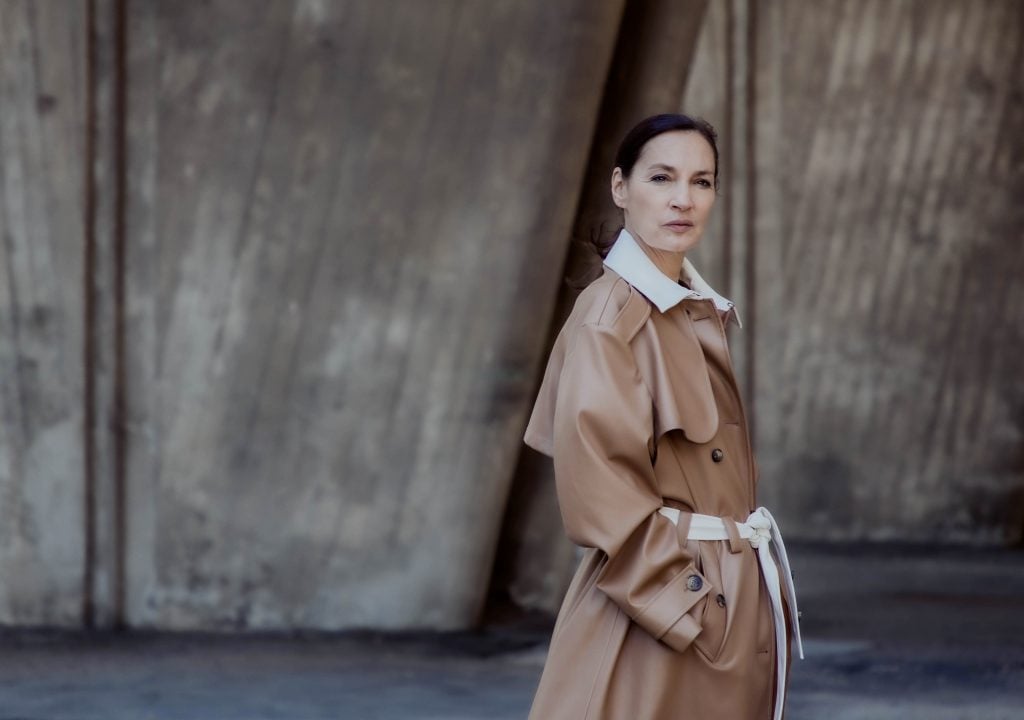
Jeanne Balibar. Gerard & Kelly, Bright Hours (2022). Courtesy of Gerard & Kelly and Marian Goodman Gallery.
I’d love to hear about how you approached the choreography with Emara Neymour-Jackson, the dancer who plays Baker in the film.
RK: The three of us would watch Baker’s films, line up a bunch of photographs—all still images—and then create pathways from one image to the next. We also created a kind of written score that described all the different qualities that we saw in her performances: feminine, masculine, modern, jazz, formal, lengthened, bent.
That would be a kind of game in the studio for creating movement, which would feel more like us and like Emara than Josephine. But the way we’d structure it in time—one thing after another, juxtaposing each movement, piecing together choreography like a collage—felt like it was aligned with Baker’s way of structuring movement.
BG: Another thing that’s important is the choreography of the gaze—the way she’s aware that you’re looking at her moving and dancing. And she has this kind of relationship with the gaze of the camera, with the spectator, that very much puts you on the inside of the game, the joke, the performance. That was very postmodern.
Baker did a lot of things where it was like, Who is Josephine Baker? She was playing so many different roles.
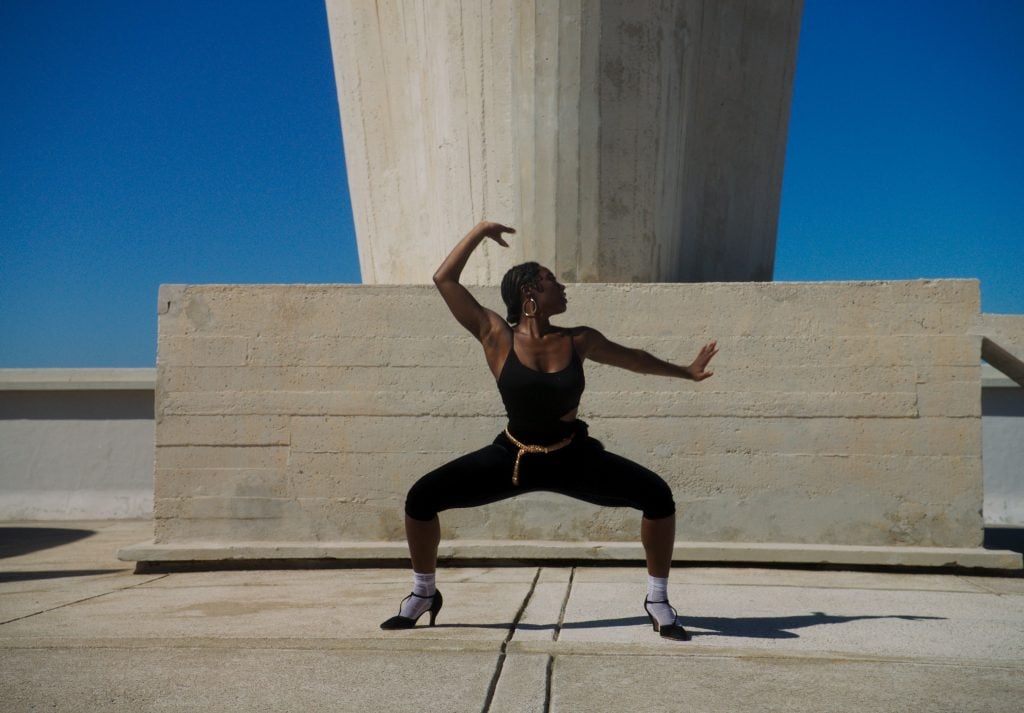
Neymour-Jackson as Josephine Baker. Gerard & Kelly, Bright Hours (2022). Courtesy of Gerard & Kelly and Marian Goodman Gallery.
What can you tell me about the role of Germain Louvet, the Paris Opera Ballet dancer, and what his dancing embodies in the film?
RK: We saw Germain’s role as kind of Le Corbusier’s fantasy. As the character is reflecting on this lost love, I think he starts to fantasize himself this dancer who could attract Josephine’s attention.
This is also our speculation—that Le Corbusier really wanted to be a dancer.
BG: Mm-hmm. [Laughs.]
RK: I think that’s not so far off either, because, you know, he was a nudist…
BG: He was always physically active…
RK: He introduced the gymnasium into his architecture, which is kind of fascinating—like, that’s so fundamental today, and Corbu was doing that in the 1930s.
At one point, Germain leans into an imprint of a human body on the side of the Cité Radieuse.
That’s Le Corbusier’s own shape that he carved into the building—he called it the “Modulor,” and he actually used it as the measuring stick for designing the Cité, and for all the buildings that followed. So, I mean, that is pretty wackadoo dancer thinking [laughs], you know? Like, Let me use my body to measure this space.
BG: I think what makes Germain’s performance so exciting was the way in which he fails to be fully the fantasy; he fails to sit within this idealized modular man. That’s part of what we wanted to do, too—through dance movement, through Moses Sumney’s music—is complicate that idea he might have for himself.
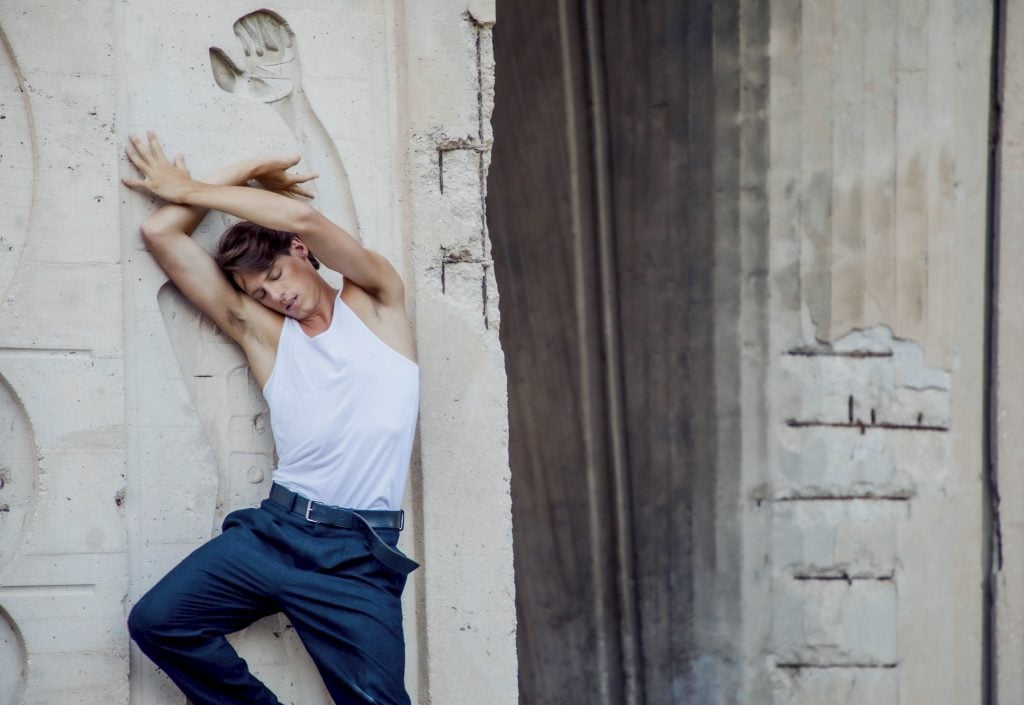
Germain Louvet in Gerard & Kelly’s Bright Hours (2022). Courtesy of Gerard & Kelly and Marian Goodman Gallery.
How did you come to collaborate with Moses Sumney on the soundtrack, and what was that like?
RK: I guess we met Moses through Solange. [Gerard & Kelly have collaborated with the singer on a number of performance works.] Moses seemed like the right collaborator, specifically around the play of gender that we were thinking about, and also to connect back to the Baker songbook and to jazz, but to help keep the vibe of the film very much now.
We were there from the conception of the work together. At one point last summer, we went out to North Carolina and worked with him there. It was a very deep collaboration.
His music was not only a source for the film’s choreography; the composition and the editing were completed alongside each other in a series of back-and-forths among the three of us. The relationship between the film and the music is itself a kind of pas de deux.
BG: You know, Moses’s view of the world and his music are so sophisticated and intelligent, and also very emotional. Oftentimes, he creates ambivalent emotional experiences. You can’t quite name exactly what you’re feeling. Is it longing? Sadness? Desire? Joy?
That’s part of what we wanted to get into: how these intimacies that are very powerful and unexpected, they kind of shatter us and create a prismatic, emotional experience. And the shattering that happens to Le Corbusier echoes in his vision: he starts to see color.